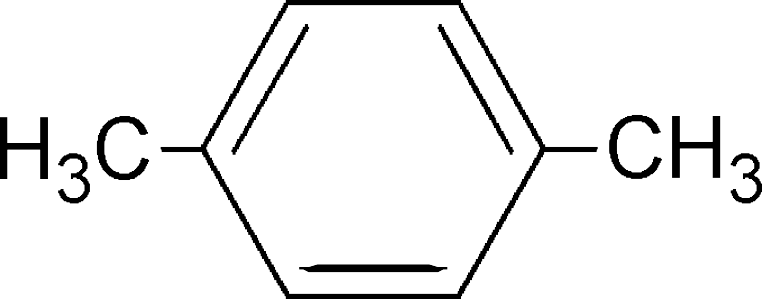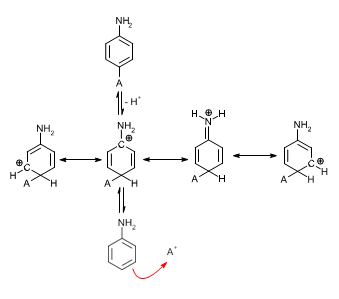78 Aromatic Hydrocarbons
LumenLearning
Naming Aromatic Compounds
Aromatic compounds are named based on the number and type of substituents on the ring.
LEARNING OBJECTIVES
Recognize the methods for naming aromatic compounds, including IUPAC nomenclature and historical names
KEY TAKEAWAYS
Key Points
- For substituted benzene rings where the substituent contains more than six carbons, the benzene ring is noted by using a phenyl prefix on the alkane name.
- For substituted benzene rings where the substituent contains less than six carbons, the alkyl chain is added as a prefix with the ending changed to -yl.
- For benzene rings with multiple substituents, the ring atoms are numbered to minimize the numbering of the substituents groups; alternatively, ortho/meta/para nomenclature can be used for disubstituted rings.
Key Terms
Aromatic compounds are ring structures with unusual stability due to delocalized pi electron density that is shared between all of the carbon atoms in the ring.
There are a number of historically common names for aromatic structures. These names are frequently used in favor of standardized IUPAC nomenclature. For example, methylbenzene is often referred to as toluene, and dimethylbenzene is often called xylene.
Naming aromatic compounds: This nomenclature tutorial video takes you through the IUPAC rules for benzene type molecules and includes the common names for substituted benzene.
Aromatic Compounds with a Single Substituent
When there is a single substituent on a benzene ring and the substituent contains six or fewer carbons, the substituent is included as a prefix to benzene. Alkyl groups are named according to the alkane series convention ending with -yl: methyl (for a single carbon), ethyl (for two carbons), propyl (for three carbons), etc.
If the substituent contains more than six carbons, the alkane portion is named first, and the aromatic ring portion is added as a suffix. For instance, an aromatic ring bonded to an 8-carbon chain would be 1-phenyloctane, and not octylbenzene.
Aromatic Compounds with Multiple Substituents
When there are multiple substituents, ring atoms are numbered to minimize the numbers assigned to the substituted positions.
Disubstituted benzene rings can be named based on the relative positions of the substituents: the prefix ortho– is used if the substituents occupy adjacent positions on the ring (1,2), meta– is used if the substituents are separated by one ring position (1,3), and para– if they are found on opposite sides of the ring (1,4).

Properties of Aromatic Compounds
Aromatic compounds are ring structures with delocalized [latex]\pi[/latex] electron density that imparts unusual stability.
LEARNING OBJECTIVES
Recognize the general properties of aromatic compounds
KEY TAKEAWAYS
Key Points
- Aromatic compounds are cyclic compounds in which all ring atoms participate in a network of [latex]\pi[/latex] bonds, resulting in unusual stability.
- Aromatic compounds are less reactive than alkenes, making them useful industrial solvents for nonpolar compounds.
- Aromatic compounds are produced from petroleum and coal tar.
Key Terms
- aromatic hydrocarbon: A compound having a closed ring of alternate single and double bonds with delocalized electrons.
- aromaticity: The property of organic compounds that have at least one conjugated ring of alternate single and double bonds, and exhibit extreme stability.
Aromatic Compounds
Aromatic compounds, originally named because of their fragrant properties, are unsaturated hydrocarbon ring structures that exhibit special properties, including unusual stability, due to their aromaticity. They are often represented as resonance structures containing single and double bonds. However, the bonding is stronger than expected for a conjugated structure, and it is more accurately depicted as delocalized electron density shared between all the atoms in the ring.
Structure of Aromatic Compounds

Aromatic compounds are cyclic structures in which each ring atom is a participant in a[latex]\pi[/latex] bond, resulting in delocalized [latex]\pi[/latex] electron density on both sides of the ring. Due to this connected network of [latex]\pi[/latex] bonds, the rings are planar, unlike the boat or table structures typical of cycloalkanes.
Physical Properties of Aromatic Compounds
Aromatic compounds are generally nonpolar and immiscible with water. As they are often unreactive, they are useful as solvents for other nonpolar compounds. Due to their high ratio of carbon to hydrogen, aromatic compounds are characterized by a sooty yellow flame.
Reactivity of Aromatic Compounds

The double bonds in aromatic compounds are less likely to participate in addition reactions than those found in typical alkenes. Instead, cyclic aromatic compounds undergo electrophilic substitution reactions (reactions in which the ring acts as an nucleophile to a suitable electrophile). When benzene participates in such substitution reactions, the product retains the stability associated with the aromatic [latex]\pi[/latex] electron system. This stability is lost in electrophilic addition because the product is not aromatic.
Sources of Aromatic Compounds
Aromatic compounds are produced from a variety of sources, including petroleum and coal tar. Poly-aromatic hydrocarbons are components of atmospheric pollution and are known carcinogens. Aromatic compounds are also interesting because of their presumed role in the origin of life as precursors to nucleotides and amino acids.
Ortho, meta, and para nomenclature of aromatic compounds: This nomenclature tutorial video takes you through the IUPAC rules for naming disubstituted benzene compounds using ortho-, meta-, and para- prefixes.
Reactions of Aromatic Compounds
Aromatic compounds can participate in a range of reactions including substitution, coupling, and hydrogenation reactions.
LEARNING OBJECTIVES
Give examples of the types of reactions that aromatic compounds typically undergo
KEY TAKEAWAYS
Key Points
- Aromatic compounds or arenes undergo substitution reactions, in which the aromatic hydrogen is replaced with an electrophile, hence their reactions proceed via electrophilic substitution.
- Arenes contain double bonds just like alkenes but they do not undergo electrophilic addition because these would result to their loss of ring aromaticity.
- The order of substitution on aromatic compounds is governed by the nature of substituents present in the aromatic ring.
- In electrophilic aromatic substitution reactions, a carbocation is generated while in nucleophilic aromatic substitutions, a carboanion is generated.
- Hydrogenation reactions convert aromatic compounds into saturated compounds.
- Metal cross-coupling such as Suzuki reaction allows formation of carbon-carbon bonds between two or more aromatic compounds.
Key Terms
- electrophile: A compound or functional group that is attractive to, and accepts electrons; accepts an electron pair from a nucleophile to form a bond.
- hydrogenation: The chemical reaction of hydrogen with another substance, especially with an unsaturated organic compound, and usually under the influence of temperature, pressure, and catalysts.
- nucleophile: A compound or functional group that is attractive to centers of positive charge and donates electrons; donates an electron pair to an electrophile to form a bond.
The benzene ring is frequently noted for the stability it gains from its aromaticity. However, aromatic compounds can participate in a variety of chemical reactions, including a range of substitution, coupling, and hydrogenation reactions. The electrons in the pi system of the benzene ring are responsible for the reactivity observed. While aromatic compounds are best represented by a continuous electron density evenly distributed around the aromatic core, the alternating single and double bonds that are commonly drawn are very useful when predicting the reactivity of aromatic compounds. Many reactions common to alkenes (carbon-carbon double bonds) also function in a similar fashion with the “double bonds” in aromatic compounds, though generally the activation barrier is higher due to the stabilizing force of aromaticity (ca. 36 kcal/mol).
Aromatic Substitution
An example of an aromatic substitution reaction is shown below. In the presence of strong sulfuric and nitric acid, a nitro group can be added to the ring.

Nucleophilic Aromatic Substitutions
In a nucleophilic aromatic substitution reaction, a nucleophile displaces a substituent on an aromatic ring. The replaced species is typically a good leaving group, like nitrogen gas or a halide ion. The presence of an electron-withdrawing group on the ring can speed up the progress of this class of reactions. Chemically, this is similar to an addition reaction to a Michael acceptor or other electron-deficient, unsaturated system, followed by an elimination reaction.
Electrophilic Aromatic Substitutions

In an electrophilic aromatic substitution reaction, a substituent on an aromatic ring is displaced by an electrophile. These reactions include aromatic nitration, aromatic halogenation, aromatic sulfonation, and Friedel-Crafts acylations and alkylations. These reactions can involve a resonance-stabilized carbocation intermediate known as a sigma complex. The reactivity can be thought of in terms of an alkene attacking a cationic species, such as in the first step of an acid-catalyzed hydration of an alkene.A number of patterns have been observed regarding the reaction of substituted benzene rings. These observations have been generalized to provide a predictive rule for electrophilic aromatic substitutions. It states that an electron-donating substituent generally accelerates substitution and directs reactivity toward the positions that are ortho and para to it on the ring, while an electron-withdrawing substituent will slow reaction progress and favor the meta position on the ring.
Coupling Reactions
Coupling reactions are reactions involving a metal catalyst that can result in the formation of a carbon-carbon bond between two radicals.
Hydrogenation
Hydrogenation can be used to create a fully saturated ring system. This is similar to the hydrogenation of an alkene to form an alkane, albeit more difficult due to the stability of the aromatic system.
LICENSES AND ATTRIBUTIONS
CC LICENSED CONTENT, SHARED PREVIOUSLY
- Curation and Revision. Provided by: Boundless.com. License: CC BY-SA: Attribution-ShareAlike
CC LICENSED CONTENT, SPECIFIC ATTRIBUTION
- Aromatic. Provided by: Wikipedia. Located at: http://en.wikipedia.org/wiki/Aromatic. License: CC BY-SA: Attribution-ShareAlike
- ortho. Provided by: Wiktionary. Located at: http://en.wiktionary.org/wiki/ortho. License: CC BY-SA: Attribution-ShareAlike
- Aromatic hydrocarbon. Provided by: Wikipedia. Located at: http://en.wikipedia.org/wiki/Aromatic_hydrocarbon. License: Public Domain: No Known Copyright
- Naming aromatic compounds. License: Public Domain: No Known Copyright. License Terms: Standard YouTube license
- Aromaticity. Provided by: Wikipedia. Located at: http://en.wikipedia.org/wiki/Aromaticity. License: CC BY-SA: Attribution-ShareAlike
- aromatic hydrocarbon. Provided by: Wiktionary. Located at: http://en.wiktionary.org/wiki/aromatic+hydrocarbon. License: CC BY-SA: Attribution-ShareAlike
- aromaticity. Provided by: Wiktionary. Located at: http://en.wiktionary.org/wiki/aromaticity. License: CC BY-SA: Attribution-ShareAlike
- Aromatic hydrocarbon. Provided by: Wikipedia. Located at: http://en.wikipedia.org/wiki/Aromatic_hydrocarbon. License: Public Domain: No Known Copyright
- Naming aromatic compounds. License: Public Domain: No Known Copyright. License Terms: Standard YouTube license
- Ortho, meta, and para nomenclature of aromatic compounds. License: Public Domain: No Known Copyright. License Terms: Standard YouTube license
- Electrophilic-aromatic-substitution-general. Provided by: Wikimedia Commons. Located at: http://commons.wikimedia.org/wiki/File:Electrophilic-aromatic-substitution-general.png. License: Public Domain: No Known Copyright
- Aromatic. Provided by: Wikipedia. Located at: http://en.wikipedia.org/wiki/Aromatic. License: Public Domain: No Known Copyright
- Aromatic hydrocarbons. Provided by: Wikipedia. Located at: http://en.wikipedia.org/wiki/Aromatic_hydrocarbons. License: CC BY-SA: Attribution-ShareAlike
- electrophile. Provided by: Wiktionary. Located at: http://en.wiktionary.org/wiki/electrophile. License: CC BY-SA: Attribution-ShareAlike
- hydrogenation. Provided by: Wiktionary. Located at: http://en.wiktionary.org/wiki/hydrogenation. License: CC BY-SA: Attribution-ShareAlike
- nucleophile. Provided by: Wiktionary. Located at: http://en.wiktionary.org/wiki/nucleophile. License: CC BY-SA: Attribution-ShareAlike
- Aromatic hydrocarbon. Provided by: Wikipedia. Located at: http://en.wikipedia.org/wiki/Aromatic_hydrocarbon. License: Public Domain: No Known Copyright
- Naming aromatic compounds. License: Public Domain: No Known Copyright. License Terms: Standard YouTube license
- Ortho, meta, and para nomenclature of aromatic compounds. License: Public Domain: No Known Copyright. License Terms: Standard YouTube license
- Electrophilic-aromatic-substitution-general. Provided by: Wikimedia Commons. Located at: http://commons.wikimedia.org/wiki/File:Electrophilic-aromatic-substitution-general.png. License: Public Domain: No Known Copyright
- Aromatic. Provided by: Wikipedia. Located at: http://en.wikipedia.org/wiki/Aromatic. License: Public Domain: No Known Copyright
- Aromatic hydrocarbon. Provided by: Wikipedia. Located at: http://en.wikipedia.org/wiki/Aromatic_hydrocarbon. License: Public Domain: No Known Copyright
- File:EAS substitution Para director.svg – Wikipedia, the free encyclopedia. Provided by: Wikipedia. Located at: http://en.wikipedia.org/w/index.php?title=File:EAS_substitution_Para_director.svg&page=1. License: CC BY-SA: Attribution-ShareAlike
This chapter is an adaptation of the chapter “Aromatic Hydrocarbons” in Boundless Chemistry by LumenLearning and is licensed under a CC BY-SA 4.0 license.
A prefix used to name an aromatic ring with two adjacent substituents.
A prefix used to name an aromatic ring with two substituents separated by one carbon on the ring.
A prefix used to name an aromatic ring with two substituents directly across from one another on the ring.
cyclic molecule consisting of carbon and hydrogen with delocalized alternating carbon-carbon single and double bonds, resulting in enhanced stability
The property of organic compounds that have at least one conjugated ring of alternate single and double bonds, and exhibit extreme stability.
A compound or functional group that is attractive to, and accepts electrons; accepts an electron pair from a nucleophile to form a bond.
The chemical reaction of hydrogen with another substance, especially with an unsaturated organic compound, and usually under the influence of temperature, pressure, and catalysts.
A compound or functional group that is attractive to centers of positive charge and donates electrons; donates an electron pair to an electrophile to form a bond.

